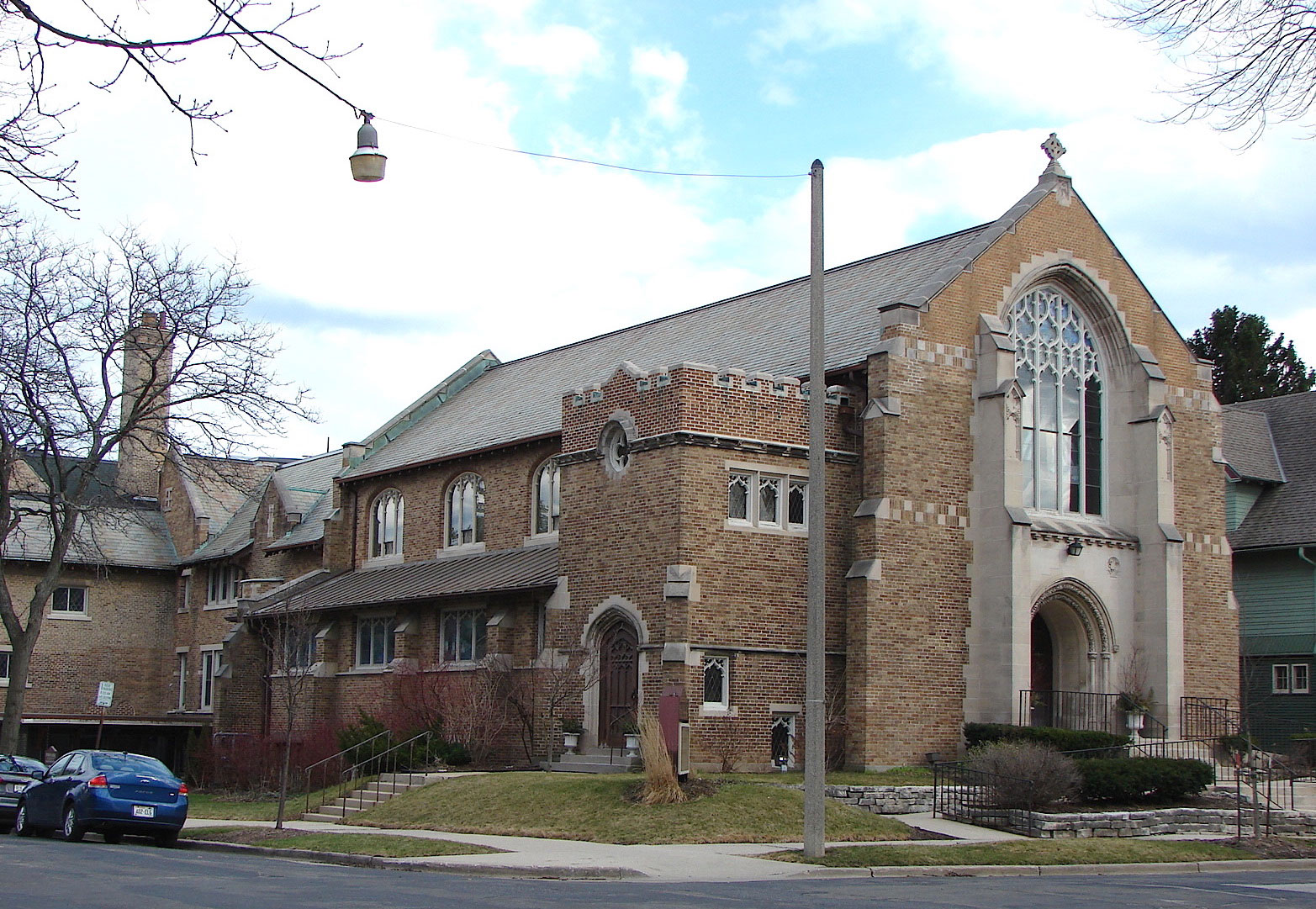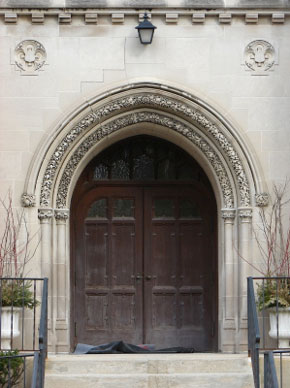44. Plymouth Congregational, 1913
Now Plymouth Church, United Church of Christ
2717 East Hampshire Avenue (at Hackett Avenue)
Architect: Alexander Eschweiler

Plymouth Church is a building of modest size with a basilican plan, like the older St. James Episcopal and All Saints Episcopal. Like most of the city’s Gothic Revival churches built at this time and later, Plymouth lacks a steeple, and the square entrance bay with its castellated top can hardly be called a tower, as it does not even reach the upper eave. The church continues the trend seen at First Unitarian and Epiphany Lutheran, with a more horizontal rather than vertical emphasis.
The architect, Alexander C. Eschweiler (1865-1940), established one of Milwaukee’s most distinguished and prolific architectural family dynasties. Born in Boston, Eschweiler moved with his parents to Milwaukee in 1882. He studied architecture at Cornell University, receiving a degree in 1890. Returning to Milwaukee, Eschweiler worked briefly in the office of Henry Koch before establishing his own office in the mid-1890s. All three of Eschweiler’s sons, Alexander Junior, Carl, and Theodore, studied architecture at Cornell and then joined their father’s firm. In 1923, the sons became partners and the firm name changed to Eschweiler and Eschweiler. The firm continued under that name after the senior Eschweiler’s death in 1940, until the office closed in 1972. The firm had a large and varied practice, including three churches in Milwaukee and several more in other Wisconsin cities and towns. Alexander Eschweiler and his sons also designed several high-rise office buildings in downtown Milwaukee, the most notable being the Art Deco landmark Milwaukee Gas Light Company building (now the Wisconsin Gas building) of 1929.
Alexander Eschweiler was striving for a certain kind of honesty with the interior of Plymouth Congregational. There are no suspended plaster ceilings that imitate the forms of Gothic stone vaulting. Instead, the ceiling is simply the underside of the roof, with the nave ceiling supported by impressive hammerbeam trusses. This approach can be seen at First Unitarian, Epiphany Lutheran, and a few other earlier Gothic Revival churches, but here the architect goes a step further, eliminating plaster altogether. The interior walls proudly show their structural materials, brick and stone, just like the exterior walls. The interior color scheme is therefore the natural color of the materials used, rather than paint. (The only structural steel in the building consists of steel columns and beams supporting the main floor above the basement meeting hall.) Eschweiler must have been pleased with the result, since his design for the larger St. Thomas Aquinas Catholic Church at 36th and Brown Streets, completed the following year, is quite similar in its form, materials, and interior design.
The highlight of Plymouth Church is its collection of windows by Tiffany Studios of New York. As originally built, the windows in the side aisles and on the west wall in the balcony had leaded glass in diamond shapes and lightly tinted colors, like the glass that remains in the clerestory windows. Most of the Tiffany windows were installed soon after the opening of the church, with the last one installed in 1927. Members of the congregation contributed the windows as gifts to the church and as memorials to deceased friends and family members.
The present building is the congregation’s fourth church since its founding in 1841. Originally called First Congregational, the name was changed to Plymouth Congregational in 1850. The name was changed again to Plymouth Church, United Church of Christ, as a result of the 1957 nationwide merger of the Congregational Church with the Evangelical and Reformed Church to form the United Church of Christ. While the congregation’s first three churches served for 8, 38, and 24 years, respectively, the present church has now been the congregation’s home for more than 100 years.
Sources:
Davis, Richard S. 50 Years of Architecture: Being an Accounting of Sorts on the Work Done in Half a Century by a Father and His Sons. Hammersmith-Kortmeyer Co., printer, c. 1943.
Eschweiler, A.C., architect. Drawings for construction of Plymouth Congregational Church, undated. Wisconsin Architectural Archive, Milwaukee Central Library, drawing set 1-877.
Flucke, Paul. Plymouth, a Church and its World: a History of Plymouth Church, Milwaukee, Wisconsin. Plymouth Church, 1984.
Historical Sketch of the Plymouth Congregational Church, Milwaukee. Plymouth Church, 1890.
Seventy-Fifth Anniversary of the Founding of Plymouth Church (First Congregational), Milwaukee, Wisconsin. Plymouth Church, 1916.
Thrall, Win. Alexander Eschweiler in Milwaukee: Celebrating a Rich Architectural Heritage. Charles Allis Art Museum, 2007.

